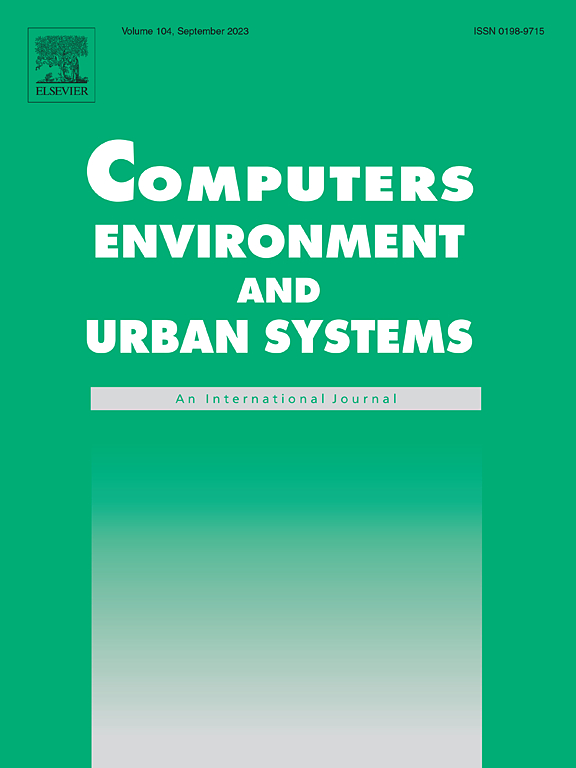街景图像在城市环境制图中的覆盖范围和偏差
IF 8.3
1区 地球科学
Q1 ENVIRONMENTAL STUDIES
Computers Environment and Urban Systems
Pub Date : 2025-01-23
DOI:10.1016/j.compenvurbsys.2025.102253
引用次数: 0
摘要
街景图像(SVI)已成为城市研究中一种有价值的数据形式,为绘制和感知城市环境提供了新的方法。然而,关于SVI的代表性、质量和可靠性的基本问题仍未得到充分探讨,例如,这些数据在多大程度上可以捕获城市,以及数据差距是否会导致偏见。本研究定位于空间数据质量和城市分析的交叉点,通过提出一种新的有效方法来估计城市环境中SVI的元素级覆盖范围,解决了这些问题。该方法综合考虑了SVI与目标元素之间的位置关系以及物理障碍物的影响。将数据质量的领域扩展到SVI,我们引入了一个评估覆盖范围的指标体系,重点关注完整性和频率维度。以伦敦为例,以建筑立面为例,进行了三个实验,以确定SVI覆盖和代表城市环境要素的能力的潜在偏差。研究发现,尽管谷歌街景在城市道路网络沿线的可用性很高,但在案例研究区域内,谷歌街景仅覆盖了62.4%的建筑物。每栋建筑的平均立面覆盖率为12.4%。SVI倾向于过度代表非住宅建筑,从而可能导致有偏差的分析,其环境要素的覆盖范围与位置有关。研究还强调了不同数据采集方式下SVI覆盖率的可变性,并提出了SVI采集的最佳采样间隔范围为50-60 m。研究结果表明,虽然SVI提供了有价值的见解,但它不是万灵药——它在城市研究中的应用需要仔细考虑数据覆盖和元素层面的代表性,以确保可靠的结果。本文章由计算机程序翻译,如有差异,请以英文原文为准。

Coverage and bias of street view imagery in mapping the urban environment
Street View Imagery (SVI) has emerged as a valuable data form in urban studies, enabling new ways to map and sense urban environments. However, fundamental concerns regarding the representativeness, quality, and reliability of SVI remain underexplored, e.g. to what extent can cities be captured by such data and do data gaps result in bias. This research, positioned at the intersection of spatial data quality and urban analytics, addresses these concerns by proposing a novel and effective method to estimate SVI's element-level coverage in the urban environment. The method integrates the positional relationships between SVI and target elements, as well as the impact of physical obstructions. Expanding the domain of data quality to SVI, we introduce an indicator system that evaluates the extent of coverage, focusing on the completeness and frequency dimensions. Taking London as a case study, three experiments are conducted to identify potential biases in SVI's ability to cover and represent urban environmental elements, using building facades as an example. It is found that despite their high availability along urban road networks, Google Street View covers only 62.4 % of buildings in the case study area. The average facade coverage per building is 12.4 %. SVI tends to over-represent non-residential buildings, thus possibly resulting in biased analyses, and its coverage of environmental elements is position-dependent. The research also highlights the variability of SVI coverage under different data acquisition practices and proposes an optimal sampling interval range of 50–60 m for SVI collection. The findings suggest that while SVI offers valuable insights, it is no panacea – its application in urban research requires careful consideration of data coverage and element-level representativeness to ensure reliable results.
求助全文
通过发布文献求助,成功后即可免费获取论文全文。
去求助
来源期刊

Computers Environment and Urban Systems
Multiple-
CiteScore
13.30
自引率
7.40%
发文量
111
审稿时长
32 days
期刊介绍:
Computers, Environment and Urban Systemsis an interdisciplinary journal publishing cutting-edge and innovative computer-based research on environmental and urban systems, that privileges the geospatial perspective. The journal welcomes original high quality scholarship of a theoretical, applied or technological nature, and provides a stimulating presentation of perspectives, research developments, overviews of important new technologies and uses of major computational, information-based, and visualization innovations. Applied and theoretical contributions demonstrate the scope of computer-based analysis fostering a better understanding of environmental and urban systems, their spatial scope and their dynamics.
 求助内容:
求助内容: 应助结果提醒方式:
应助结果提醒方式:


